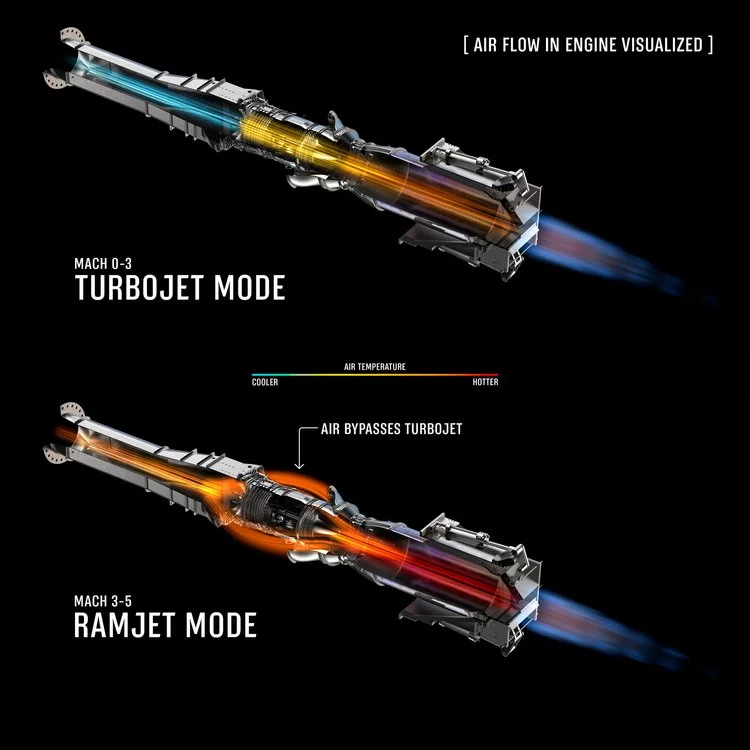Atlanta company Hermeus has its sights set on Mach 4 next year, to beat the Mach 3.3 benchmark set by the SR-71 Blackbird way back in 1976. Watch its Chimera hybrid engine nailing the switch between low-speed turbojet mode and hypersonic ramjet mode.
Under US Air Force funding, the company is charging forth on its Quarterhorse project, a nuggety, dart-shaped, remotely-piloted UAV designed to sprint faster than any aircraft before it.
With funding only awarded back in 2021, the pace of development on this one is pretty wild, and Hermeus claims it's still on track to break the outright air-breathing aircraft speed record next year.
To get there, it needs an engine similar to what the Blackbird ran; a hybrid propulsion unit that can operate in two stages. When it's time for maximum thrust at hypersonic speeds, you need a ramjet. But ramjets rely on airflow to compress and heat air ready for combustion; they can't start you off on a runway, they produce basically zero thrust below Mach 0.5, and they don't become more efficient than a regular turbojet below somewhere around Mach 3.

Thus, the hybrid. Hermeus has designed and built an engine it calls the Chimera that runs a ramjet and a slower-speed turbojet in the same tube. The turbojet is functional even at a standstill, so it's capable of getting Quarterhorse down a runway and into the air, where it'll accelerate to Mach 3 before shutting off. The supersonic intake air will then be routed around the turbojet into the ramjet, which will compress it, ignite it, and blast the aircraft to its top speed.
The team took the Chimera engine to the Notre Dame Turbomachinery Lab last year, where it was mounted to a bench in a high-Mach test facility specially modified to deliver inlet air at speeds high enough to simulate Mach 4 flight. The engineers ran the jet in bursts, typically late at night to mitigate the insane electricity costs involved. The test campaign lasted a full five months before the Hermeus team was able to announce it had achieved a full and stable transition between the turbojet and ramjet stages in November.
“The Notre Dame facility allowed us to create conditions similar to what we’ll see in flight,” said Hermeus co-founder and chief technology officer Glenn Case in a press release. “Completing this testing on the ground significantly de-risks our Quarterhorse flight test campaign which will begin late [this] year.”

NDTL director Joshua Cameron said, “We are pleased that Hermeus chose NDTL as their partner for this exciting test program.” Cameron, who is also a research assistant professor in Notre Dame’s Department of Aerospace and Mechanical Engineering, added, “I am also so proud of my team for developing the facility and executing a successful test campaign on a very aggressive schedule.”
Beyond Quarterhorse, Hermeus is planning a larger Darkhorse unmanned platform, which will run an enormous Pratt & Whitney F100 engine out of an F16 as its turbojet stage. This machine is targeted at delivering sustained hypersonic flight at Mach 5, a military capability no country has yet in its arsenal.

But the end goal for Hermeus is not military. Its ultimate plan at this stage is to build a civilian, commercial, Mach 5 hypersonic airliner with a titanium-alloy body and a range around 4,600 miles (7,400 km), capable of ferrying up to 20 passengers across 125 different trans-oceanic routes. This "Halcyon" plane would blast you from Paris to New York in 90 minutes at a monster 90,000 ft altitude, higher than the legendary Blackbird was allowed to cruise.
Five times faster than any commercial aircraft on the market today, Halcyon frankly looks like a bit of a pipe dream at this stage, given that it's an exponentially harder thing to build, test and certify than a supersonic jet – and even those are proving critically difficult, with Florida company Aerion shutting down in 2021 despite more than US$10 billion in advance orders for its 50-passenger Mach 1.4 jet. Not to mention, it's a huge leap from developing military UAVs to getting a hypersonic airliner certified for commercial flight and into serial production, let alone cleared to fly at those speeds. Don't hold your breath on this one.
Still, Hermeus has made some pretty wild progress since it was founded in 2018. It's a young company, with a preternaturally young-looking team, working on some groundbreaking gear. They're shooting for the moon, who knows where they'll land? Check out the engine bench test in the video below, it's as awesome as you'd expect.
Source: Hermeus










